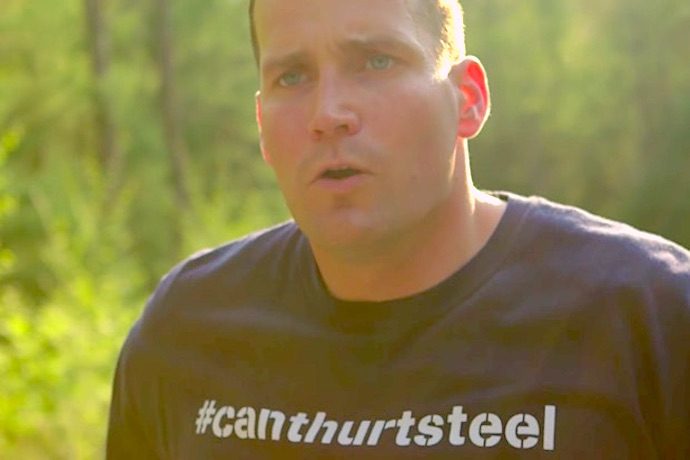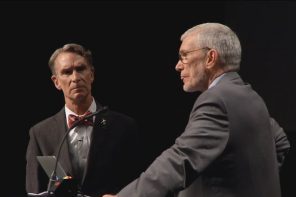In a video titled “Man of Steel,” J.J. Hanson goes for a run along a tree-lined road, pumps iron in his garage, plays in a park with his three-year-old son, and walks hand in hand with his beautiful wife.
This idyllic image is spliced with tragedy: in 2014, Hanson was diagnosed with a quickly growing brain tumor. He was given four months to live.
More than two years later, Hanson is still alive. And he has positioned himself as the new face of a movement fighting against legislation that will give aid in dying to terminally ill patients (opponents call these “assisted suicide” laws).
After his diagnosis, Hanson founded the Patients’ Rights Action Fund (PRAF). This fall, he has been working to thwart new aid-in-dying legislation in New York and Washington, D.C., as well as a referendum in Colorado (which ultimately passed). In this effort, he is clearly trying to position himself as the antithesis to Brittany Maynard, the 29-year-old Californian, diagnosed with the same cancer as Hanson, who died in 2014 shortly after appearing on the cover of People magazine under the headline “My Decision to Die.”
Hanson is not the first high-profile activist to oppose aid-in-dying legislation. But his invocation of masculine strength and willful suffering is unique—and it can tell us a lot about the future, and the limits, of anti-aid-in-dying work in the U.S.
In “Man of Steel” Hanson tells the camera that at the time of his diagnosis he wondered, “Would this be easier if I just gave up?” Strings play in the background. He remembers thinking, “What if I just said I’ve had enough and ended it?”
But Hanson, an ex-Marine, didn’t end it, because that would have been giving up. His father, also a military man, repeated a motto to his children: “You can’t hurt steel.” You go to school when you’re sick, and you fight when you’re down. In the video, Hanson credits his miraculous survival to faith, family, and fighting. “Just because a man said it, you don’t accept it,” he says of his doctor’s diagnosis. His will to live, the video suggests, has allowed him to do so.
This may seem like a personal narrative, evoked to navigate a personal experience. But Hanson has linked his story to a legal battle, aiming to prevent others with terminal diagnoses from ending their dying.
Typically, Catholic anti-aid-in-dying activists rely on the theological argument that our bodies, and therefore our medical decisions regarding death, belong to God. Hanson subverts this argument by claiming that his decisions are his alone—made in the context of his faith and family, but still his own. It is Hanson’s reiterated autonomy and his continued survival that have made him a media star.
Hanson’s story is very different from that of activists who hope to legalize aid-in-dying measures. Most are older than Hanson. Some have survived treatment and remission, only to experience recurrence of their terminal diseases. Rather than try yet another experimental treatment, they’ve come to see drugs, chemotherapy, radiation, and endless tests as a kind of torture they are no longer willing to endure.
As the nation’s population has aged, the dying process has been elongated by medical technology. That progress has been incredibly beneficial to many, yes, but at times it can cause horrifying pain. Baby boomers have watched their friends and family members waste away in hospitals and nursing homes, the natural dying process propped up by yet another operation, antibiotic, or debilitating drug regimen. Many have decided they want no part of it.
The aid-in-dying movement is a response to their desire to avoid prolonged suffering in the final weeks and months of life. It allows a mentally competent, terminally ill patient to receive a prescription for a lethal dose of medication from a doctor. Two requests, with an intermediary waiting period, are required. In the nearly 20 years since Oregon passed the nation’s first Death with Dignity bill, the movement to legalize aid-in-dying—and its corollary, the anti-“assisted suicide” movement—have employed grassroots campaigns in dozens of states across the country. Since then, four more states have legalized aid in dying: Washington (2008), Montana (2010), Vermont (2013), and California (2015).
This fall, the District of Columbia’s Council on Health and Human Services Committee approved continuation of the full council’s vote before the end of the year. New York currently has a pending court case and legislation; many observers suggest that passage in such a large, influential state could tip the balance for other states or even give the Supreme Court reason to reconsider its decision to leave aid-in-dying decisions to the states.
These kinds of initiatives value patient autonomy. In response, their opponents tend to valorize suffering. They speak of a society where pain, while tragic, is a necessary sacrifice to create a “culture of life.”
These stories resonate; narratives of pain have an enduring influence on American health care access and delivery. Patients who are strong, who “fight the good fight” are survivors. To avoid pain is to be understood as weak or selfish if it can perpetuate life. Embracing trials can prove our value in the sight of others and in the sight of God. For opponents of aid-in-dying laws, that legislation subverts the narrative of salvation, moral edification, and instructive suffering.
Hanson puts a more traditionally masculine spin on that narrative. His story appeals to a conservative value system that is predominant among legislators and social conservatives: strength, nationalism, suffering for a cause, personal independence, and perseverance—paradigms of family, faith, and morality that privilege male headship and male decision-making, not only for themselves but for others.
In an interview with CBS’s Sunday Morning Hanson states that “economic justice” is the reason he founded PRAF. In September he told Catholic News Service that “it’s a social justice issue, it’s an ethical issue, it’s a fairness issue, and those who really are concerned about justice and equality have to be willing to consider all the impact [physician-assisted suicide] would have on all the poorest and most socially and economically vulnerable populations.”
In this mode, Hanson can often sound like a Democrat or a social justice Catholic, and there are justifiable concerns about the abuse of aid-in-dying methods. But nearly 20 years of data from Oregon have yielded no proof of such abuse.
Hanson’s objective is to paternalistically prevent others, including the economically oppressed, from having medical decision-making autonomy—something supported by a majority of the population.
Still, Hanson is being championed by many religious opponents of aid in dying as a clear voice in the movement; he has formed an alliance with the Catholic Church and other likeminded organizations. He is a former aide to New York Democratic governors Eliot Spitzer and David J. Paterson, which gives his story a satisfying conversion narrative. “Hanson went through a transformation,” wrote John Burger at the Catholic website Aleteia. To some, Hanson is living proof that cancer can be beaten, and his survival is both a miracle and a lesson that perseverance pays off.
“J.J. Hanson has stared death in the face and fought back,” wrote the National Catholic Register in March, emphasizing his military service.
Does Hanson’s muscular Christian approach represent a viable future for the anti-aid-in-dying movement? Probably not. But the reasons it fails are instructive.
Hanson’s message—of reliance on God, of fighting against all odds, of the soldier suffering for family, nation, and a higher purpose—appeal to the (male) patriotism and paternalism of social conservatives. But their numbers are dwindling. As the country diversifies, there’s more space for laws that accommodate a broader understanding of moral behavior, ethical medical practice, and patient autonomy for everyone.
Hanson is the embodiment of a fading faithful man archetype that no longer is embraced by a majority of the U.S. population. The seeming return to “traditional values” that Donald Trump’s election brings is unlikely to halt state-level gains for the aid in dying movement, because autonomy arguments look and sound a lot like libertarian, anti-government rhetoric when enacted by (or on behalf of) white males. Hanson’s “traditionalism” may appear to be on the side of a freshly empowered force within American culture, but his objective isn’t. Men support legalization of aid-in-dying at higher rates than women. A narrative that prizes autonomy—which has its own male-gendered presentation—seems to be winning out over a masculine narrative of battle.
Hanson is a tempting spokesperson for the anti-aid-in-dying movement because he represents its “traditional” family values, a nostalgic view of male independence and dominance within an idealized conception of nuclear families. But through its rhetoric of autonomy, the aid-in-dying movement is side-stepping this static ideology, with the support of the general population. Not even Hanson can stop that.
* * *
Also on The Cubit: The politics of imaging the womb





